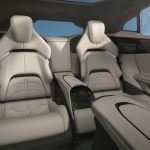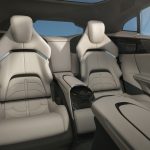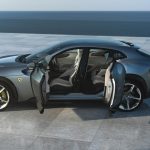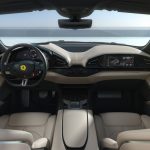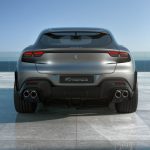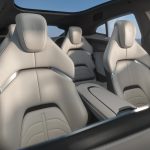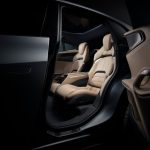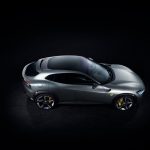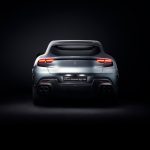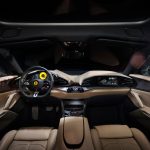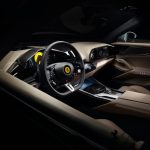Auto
Ferrari’s Purosangue Is A V12-Powered Four-Door Car That Rewrites The Brand’s 75-Year History

After years of anticipation by the international automotive fraternity, Ferrari today unveiled the Purosangue, the first ever four-door, four-seater car in the Prancing Horse’s 75-year history, in the magnificently atmospheric surroundings of the Teatro del Silenzio in Lajatico (Pisa).
Since the marque’s earliest years, 2+2 cars (i.e. with two front and two smaller back seats) have played a significant role in its strategy. Many Ferraris have made combining benchmark performance with first-class comfort one of the pillars of their success.
Now, in the culmination of 75 years of leading-edge research, Ferrari has created a car that is unique on the world stage: not only do performance, driving pleasure and comfort coexist in perfect harmony, but it is also a peerless encapsulation of the Prancing Horse’s iconic DNA. Which is the reason why the name Purosangue, Italian for ‘thoroughbred’, was chosen.

To enable the company to achieve the ambitious goals set for this project and create a car worthy of a place in its range, a completely different layout and innovative proportions compared to modern GT archetypes (so-called crossovers and SUVs) were adopted.
The average modern GT’s engine is mounted forwards in the car, almost straddling the front axle with the gearbox coupled directly to it: this results in less than optimal weight distribution that delivers driving dynamics and driving pleasure well short of the standards of excellence to which Prancing Horse clients and enthusiasts have become accustomed.
The Purosangue, on the other hand, has a mid-front-mounted engine with the gearbox at the rear to create a sporty transaxle layout. The Power Transfer Unit (PTU) is coupled in front of the engine to provide a unique 4×4 transmission. This delivers exactly the 49:51 weight distribution that Maranello’s engineers deem optimal for a mid-front-engined sports car.
The Purosangue stands head and shoulders above the rest of the market thanks to its performance and comfort. It is the only car with these proportions to sport a mid-front-mounted, naturally-aspirated V12: Maranello’s most iconic engine debuts in this brand new configuration to ensure the car unleashes more power than any other in the segment (725 cv) whilst guaranteeing the most enthralling Ferrari engine soundtrack. Furthermore, it can deliver 80 per cent torque even at low revs for unique driving pleasure at all times.
The Purosangue’s aero development focused on making the bodywork, underbody and rear diffuser as efficient as possible. New solutions include synergy between the front bumper and wheel arch trim which generates an air curtain that aerodynamically seals the front wheels, preventing turbulent transverse air flows from being generated.

Ferrari has also given the Purosangue the very latest iterations of the vehicle dynamic control systems introduced on its most powerful and exclusive sports cars, including independent four-wheel steering and ABS ‘evo’ with the 6-way Chassis Dynamic Sensor (6w-CDS). Making its world debut is the F.A.S.T. (Ferrari Active Suspension Technology) system. This very effectively controls body roll in corners as well as the tyre contact patch over high-frequency bumps to deliver the same performance and handling response as in one of the marque’s sports cars.
The all-new chassis has a carbon-fibre roof as standard to keep weight down and lower the centre of gravity. Redesigning the bodyshell from scratch also meant the designers could incorporate rear-hinged back doors (welcome doors) to make ingress and egress easier while keeping the car as compact as possible. The cabin has four generous heated electric seats that will comfortably accommodate four adults. The boot is the largest ever seen on a Ferrari and the rear seats fold to increase the luggage space. Naturally enough, the Purosangue has a more commanding driving position than other Ferraris, but the configuration is the same as on every other Ferrari. As a result, the driving position is still intimate and close to the floor to provide greater connection to the car’s dynamic capabilities.
The Purosangue offers class-leading performance figures (from 0 to 100 km/h in 3.3 s and from 0 to 200 in 10.6 s); the driving position and the heady, naturally-aspirated V12 soundtrack deliver an entirely new yet also entirely Ferrari driving experience. The fact that a vast array of comfort-focused content is provided as standard, such as the Burmester© audio system, and that the many optional extras including the brand-new Alcantara® upholstery, derived from certified recycled polyester, make the PUROSANGUE the most complete four-door, four-seater in the segment.
POWERTRAIN

The Purosangue’s engine (code-named F140IA) maintains the architecture that made the Prancing Horse’s most recent 12-cylinders so successful i.e. a 65° angle between its cylinder banks, a 6.5-litre capacity, dry sump and high-pressure direct injection. It was designed, however, to produce the highest amount of torque at low revs possible without losing the feeling of linear, never-ending power typical of Ferrari’s naturally-aspirated V12s. 80 per cent of the maximum torque is on tap at just 2100 rpm and it peaks at 716 Nm at 6250 rpm. Maximum power of 725 cv is reached at 7750 rpm and throttle response is characteristic of a real sports car.
Intake, timing and exhaust systems have been completely redesigned, while the cylinder heads are derived from the 812 Competizione. Huge attention was lavished on improving mechanical and combustion efficiency, employing Formula 1-inspired calibration concepts.
The result is the most powerful engine ever developed by Ferrari for a four-seater car, the most powerful vehicle in its segment, as well as the only one capable of delivering that instantly recognisable Ferrari V12 soundtrack.
To guarantee maximum mechanical efficiency, the rotating masses have been redesigned. The nitrided steel crankshaft was modified to lengthen the stroke and the internal oil passageways have been redesigned to improve oil flow to the big-end bearings. Lower bearing clearance tolerances improve consumption. The coolant and oil pump assembly was also redesigned focussing on the scavenge section to reduce friction and mass thanks to the adoption of smaller diameter rotors and optimising the inlets and outlets as well as the rotor seals.
The valve train timing is all new, while the new finishing process for the camshafts has considerably reduced the surface roughness and the friction coefficient between the lobes, the shafts themselves and the hydraulic tappets.
To optimise the torque curve and ensure a continual increase across the rev range, the geometry of the intake ducts and plenums was revised. The geometry of the exhaust system was also optimised to increase permeability reduce back pressure. There are specific pistons with a redesigned crown to increase combustion efficiency.
The engine’s direct injection system comprises two high-pressure fuel pumps (350 bar) that deliver petrol to the injectors in the combustion chambers. The ignition system, comprising 12 coils and spark plugs, is constantly monitored by the ECU which has an ion-sensing system that measures ionising currents to control ignition timing.
It has a single- and multi-spark function to make the combustion as efficient as possible at all revs. The ECU also controls combustion in the chamber to ensure that the engine is always working at peak thermodynamic efficiency, thanks to a sophisticated strategy that recognises the octane rating (RON) of the fuel in the tank and adjusts the advance to suit. The engine strategy includes a new patented function derived from Ferrari’s Formula expertise that optimises the torque during transient acceleration manoeuvres in the low and mid-range.

The F140IA’s soundtrack is a superb example of integration between the glorious symphony created by the engine’s combustion sequence and Ferrari’s ability to control the acoustics in the cabin. The equal-length exhaust manifolds are tuned to guarantee the 12 cylinders are in perfect harmony.
The new plenum with an optimised intake duct accompanies the V12’s high notes with the body of the medium frequencies. The two progressive silencers, the response of which is now included in the Manettino settings, cater for in-town and performance driving. The resulting soundtrack is typical Ferrari, with that unmistakable V12 harmonics that are present, yet subtle, until the driver accelerates hard: as the engine approaches the 8250 rpm red-line, there’s an enthralling crescendo that reaches its pinnacle at the kind of high revs only Ferrari’s engines can deliver.
The layout of the 8-speed, oil-bath dual-clutch transmission was optimised through the adoption of a dry sump and a significantly more compact clutch assembly, shaving 15 mm off the installed height in the car which, in turn, lowers the centre of gravity by the same amount. The new clutch’s performance is 35 per cent higher, transmitting up to 1200 Nm in dynamic torque during gear shifts.
Thanks to new-generation actuation hydraulics, clutch fill times are now faster so total gear shift times have been reduced compared to the previous 7-speed DCT. New gear ratios mean that the spacings are shorter and very progressive, and a longer top ratio is geared for greater economy in motorway driving. Downshifts have been calibrated to optimise smooth shifting with a specific focus on driving pleasure and emphasising the sound of the new V12 engine.
CHASSIS AND BODY

The Purosangue’s chassis is completely new and was designed from scratch with the aim of producing a structure of uncompromising rigidity. The lower chassis structure is made entirely from high-strength aluminium alloy and draws on Ferrari’s enormous experience in the optimal use of these light alloys. Together with the structural elements of the upper body, it makes up a spaceframe chassis comprised of closed-section extrusions connected by castings into which load-bearing aluminium sheet metal elements are integrated.
The chassis is thus lighter than Ferrari’s previous four-seaters’ despite being larger. Improved torsional rigidity (+30 per cent) and beam stiffness (+25 per cent) figures are both fundamental in improving NVH characteristics and thus comfort by smoothly and silently absorbing asperities in road surfaces as well as providing an exceptional feeling of structural integrity.
The extensive use of hollow castings with thin walls – made using internal cores – helped optimise the structure, maximising performance and guaranteeing improved continuity in the stress lines which, in turn, guarantees all-important occupant safety requirements. Furthermore, this particular technology improves assembly quality thanks to more precise integration, fewer components and the consequent reduction in weld lines.
The bodyshell is made from materials ranging from aluminium to carbon-fibre, with the introduction of high-strength steel in important areas and flanking the mechanical joins with structural adhesive. Combining these different materials guaranteed maximum strength where required and also lightweight in areas not subject to stress.
High-strength steel is used for the anti-intrusion bars, the reinforcements on the main nodes and the B-pillar. Our meticulous attention to detail at the design stage also resulted in the use of different materials within individual components. One example is the single rear door hinge: the fixed part is an aluminium casting while the mobile part is constructed from hot-stamped steel.
The single-shell carbon-fibre roof with integrated soundproofing is completely new and delivers rigidity levels on par with a glass roof while weighing 20 per cent less than an aluminium roof with soundproofing. From an ergonomic perspective, the brand focused on offering as much ingress space as possible whilst still keeping the wheelbase compact.
To do this, Ferrari opted for a traditional opening for the front doors with a 63-degree opening (five degrees wider than on our other models) – combined with a brand-new electric, rear-hinged back door with a 79-degree opening. Aside from referencing the bonnet opening on the Ferrari Monza SP1/SP2 and other legendary Ferraris from the past, the Purosangue’s front-hinged bonnet also allowed to craft extreme forms in the A-pillar area. The gooseneck hinge assembly for the bonnet is made from aluminium for solidity and stability when opened.
The aluminium rear hatch is electrically activated: two electric Stabilus tailgate lifters allow it to be opened to 73 degrees for easy access to the boot, and to make loading and unloading even the largest of luggage simple.
AERODYNAMICS

The very different volumes and constraints of the truly unique Purosangue posed a completely new challenge for Ferrari’s aerodynamic department, so a radical rethink of both methods and solutions was demanded. The extremely ambitious drag reduction target, the specific usability and accessibility demands of this particular model, and the need to cool the imposing V12 and ancillaries demanded hundreds of hours in the wind tunnel and thousands of CFD (Computational Fluid Dynamics) simulations. The kind of development work dedicated to the fastest and most powerful sports cars in the range, in fact.
The primary focus of Purosangue’s aero design was the car’s centreline section, essential to both the airflow design and to reduce the drag coefficient (Cd), as well as minimising the frontal surface area. The car’s front silhouette was designed to create the most seamless continuity of profile possible between the area of maximum curvature of the bonnet and the windscreen header rail. The rear area of the roof, the rear screen and the spoiler, on the other hand, demanded the most work because it is fundamental to managing flow separations and pressure fields.
The best possible compromise between the need for the smoothest design possible for the roof-rear screen line and the need to reduce the height of the tail itself was achieved by using two elements that complete the aero package for the rear of the car: the suspended spoiler and the nolder on the lip of the boot. While the suspended spoiler helps neutralise the curvature of the roof downstream of the area over the heads of the rear-seat passengers, the nolder, which is barely 7mm high, channels the wake vortices to create a slight recompression at the tail of the car.
Moving from the centreline section to the rear volume, a scoop can be seen starting at the rear of the roof and extending onto the rear screen which creates two crests, one on each side of it. This solution helps to maintain the headspace required for the rear-seat passengers whilst still correctly separating the flows from the upper part of the roof and those along the greenhouse area.
Also important to the aero development of the Purosangue was the wake from the wheels: several aero solutions were implemented to tackle this issue, including integrating louvres into the floating wheelarch trim front and rear. The most complex system, however, is at the front where both the bumper and louvre work in synergy to create a powerful air curtain that aerodynamically seals the front wheels, preventing the generation of transverse turbulence. A duct has been created between the front bumper on the outside of the side air intakes and the vertical fin. This duct is calibrated to accelerate the flow towards the blown area in the louvre and create an energised blade of air at an angle to the outer shoulder of the tyre. The outer surface of the louvre then deflects the flow along the flank.
At the rear of the front wheelarch trim there is a further duct that is profiled to maximise air extraction from inside the wheel housing. The same solution is adopted on the rear wheelarches with a vent in the rear wheelarch trim. Its exterior surface has also been profiled to optimise the management of the rear detachment point of the flow, which runs along the flanks and wheels.
The suspended wing on the bonnet, just ahead of the A-pillar, dubbed the aerobridge in reference to a similar element introduced on the F12berlinetta, plays a very different role to its namesake. While the latter’s aerobridge deflected the airflow from the bonnet downwards to boost downforce, the one on the Purosangue is designed to reduce drag.
The air passing under the wing on the bonnet is energised locally to reduce the negative impact of the vortex at the base of the windscreen, and to accelerate the flow to increase the amount of air being evacuated from a vent hidden by the aerobridge, which is part of a complex system of air ducts fed by the intake located over the headlights. This mass of air is channelled towards the front wheel arch. These flows coming from the front of the car are naturally vented through the louvres at the top of the front wheel housing and then continue on into the engine compartment until they reach the vent under the aerobridge. Similarly, to reduce overpressure inside the rear wheel housing, a vent has been added just beneath the taillights (in an area of natural suction) that leads from a duct inside the rear wheel arch.
A blown channel from the lower part of the front bumper towards the underbody reduces the areas naturally under compression on the front bumper, maximising the quantity of air being channelled towards the underbody, an element already used on other Ferraris. In this case, however, it is put to a different use: the energised flow channelled along the underbody by the blown area meets the surfaces of the underbody specifically designed to generate suction near the evacuation point of the central radiators on the front underbody. This maximises cooling of the central radiating masses as efficiently as possible and also allowed the design of a much smaller radiator intake. The Purosangue’s higher ground clearance means that the exposed area of the wheels makes a significant contribution to drag: as a result, negative ramps were integrated ahead of the front wheels to maximise the car’s downforce.
The curves of the body’s surfaces were designed to fair in the front wheels and wishbones, thereby limiting the amount of air entering the wheel arch as much as possible. Pivotal to this effect is a small flap fitted on the lower suspension wishbone. The low-pressure areas that occur naturally behind the front wheels were used to create two areas of evacuation that boost the efficiency of radiating masses by reducing overpressure in the engine compartment and reducing drag.
The rear diffuser design is, once again, the result of in-depth optimisation that focused principally on the synergy between the diffuser itself, the upper body and the rear bumper. The airflow that strikes the diffuser is gradually expanded and controlled. At the end of this expansion, a subtle nolder detaches the flow after slightly recompressing it. This boosts the system’s efficiency, simultaneously maximising hot air extraction from the area around the gearbox and exhaust system compartments.
The Purosangue doesn’t have a rear windscreen wiper, so the rear screen is cleaned by the airflow along the glass surfaces at the rear. The lower surface of the suspended spoiler is curved to guarantee the airflow is at the right speed and direct it towards the rear screen. There are two pairs of vortex generators at each end of the lower surface of the spoiler, which optimises the uniformity of the scrubbing. These counteract the vorticity naturally caused by the C-pillar, and also work in synergy with the specific shape of the rear screen itself.
The unconventional location of the headlights made it possible to create two air intakes above and below the DRL. The upper one is used to channel air into the complex blown system which vents underneath the front aerobridge. The lower one, on the other hand, is used to channel air to the brake cooling system. The design of the vertical outside surfaces of both air intakes includes an air-catcher which maximises the quantity of air channelled through them.
Lower down are the intakes for the radiating masses. As seen from the front, the one on the right is the radiator for the active dampers, which guarantee superb occupant comfort even on very rough surfaces, while the one on the left feeds air into the radiator for the Power Transfer Unit (PTU) circuit, a torque vectoring electronic differential. Lastly, the central intake cools both the condenser for the air conditioning circuit, to guarantee optimally comfortable cabin temperatures, and the iconic, naturally-aspirated V12’s oil and coolant radiators.
VEHICLE DYNAMICS
Development of the Purosangue’s dynamic performance focused on creating a car that was completely unprecedented on the world stage: a model offering usability and comfort standards that would position it at the very top of the market as well as delivering signature Ferrari vehicle dynamics and performance on a par with the rest of the range.
The Purosangue boasts a unique, innovative system that is a world first: Ferrari Active Suspension Technology (F.A.S.T.) using Multimatic’s True Active Spool Valve (TASV) System. Compared to other solutions on the market, this new suspension archetype offers numerous advantages, starting with electric motor actuation: a hydraulic shock absorber combined with an electric motor that rotates with it ensures that body and wheels can be controlled actively at higher frequencies than traditional active systems.
The advantage of Ferrari’s FAST system is the speed of the four 48-volt actuators which can apply force in the direction of the shock absorber’s stroke. The high-power density, the three-phase brushless electric motor was co-designed by Ferrari. The motor uses “slotless” technology (no traditional stator windings) to reduce radial dimensions to a minimum. The rotor minimises inertia as every movement of the damper piston corresponds to a rotation of the motor. From a mechanical point of view, force is transmitted via worm gear designed to reduce friction, inertia and clearances.
The FAST system uses accelerometers and position sensors on each suspension and interfaces with the Side Slip Control (SSC 8.0) and the 6w-CDS sensor. Ferrari’s proprietary control logic, together with the actuators supplied by Multimatic©, electronically manages every performance element of the system.
The FAST system optimises maximum cornering performance thanks to the variable and continual distribution of the roll rigidity and to the lower roll centre (reduced by up to 10mm), to the benefit of the side force acting on the tyres and the balance between over- and understeer. The high-frequency control regulates both body motion and the wheels’ movement, thus reducing roll and pitch as well as absorbing road surface asperities.
As well as the FAST system, the Purosangue is equipped with a new generation front semi-virtual, high wishbone suspension where the lower wishbone has two attachment points on the hub carrier. This solution means the virtual lower kingpin attachment point created by the two arms is very close to the wheel centre, thereby drastically reducing the scrub radius, i.e. the distance between the point of intersection of the extension of the kingpin axis and the centre of the tyre contact patch at ground level. This makes the steering wheel less sensitive to road irregularities and braking.
The Purosangue is equipped with the new ABS ‘evo’ controller co-designed with Bosch® and integrated with the brake-by-wire system that debuted on the 296 GTB. For the Purosangue its function has been further developed to cope with low grip surfaces and in all Manettino settings, thus optimising performance and repeatability in all road conditions. This new controller uses information from the Electronic Stability Control (ESC) to much more precisely estimate the car’s speed in order to determine the slip target for the four wheels under braking. This improved accuracy means that the longitudinal force of the four tyres can be better exploited while more accurate estimation also means that repeatability of the manoeuvre around its target value can be maximised, reducing dispersion due to natural variations caused, for instance, by the condition of the tarmac.
The EPS-based grip estimation system, originally developed for the 296 GTB, has also been honed for driving in the snow or on other low-grip surfaces. Using the data in the ECU and the slip angle calculated by the SSC 8.0, the logic can calculate the level of grip between the contact patch of the tyre and the road during steering inputs. This provides an accurate estimation even when the car is not being driven on the limit, thus making the self-learning function of grip faster and the grip estimation in all grip conditions more precise.
On the Purosangue, the 4RM-S system developed for the GTC4Lusso has been further evolved and now inherits the innovations made to the control logic developed for the SF90 Stradale’s 4WD system, coupled with the new independent 4WS seen on the 812 Competizione. Yaw management in cornering when accelerating is therefore optimised by a combination of Torque Vectoring on the front axle, distribution of torque to the rear tyres by the E-Diff and the generation of lateral force by the 4WS. The new electronic management delivers a significant increase in performance in relation to precision of control of the position of each single actuator, faster axle response time and consequent improved precision of the lateral force generated.
All the above technologies are incorporated in the 8.0 version of the Side Slip Angle Control which feeds a shared language to all the controllers to identify the best way to maximise performance. The SSC 8.0 in fact integrates all the car’s controls (steering, traction and vertical control) active on all four corners of the car and creates a natural synergy with the new ABS evo.
Particular emphasis has been placed on new objective longitudinal indicators of driving thrills specific to the Purosangue’s performance targets. Alongside traditional constantly increasing acceleration figures and reduced response times, in-gear acceleration when in manual has been honed to emphasise the superb elasticity and pick-up that are most definitely unique to the Purosangue.
The Purosangue exploits the new 8-speed DCT’s potential from all angles: mechanical, power and control. The ratios are the same as on the SF90 Stradale and 296 GTB. With larger tyres, this solution gives ratios that are shorter than on previous Ferrari 4-seaters to the benefit of more progressive performance under acceleration. The eighth gear is designed for a more relaxed experience in long-distance driving.
The transmission’s software control benefits both in terms of performance contents (reduction in Up and Down shift times of around 18 per cent) and the “Sailing” function which allows the engine and gearbox to be automatically decoupled to guarantee greater smoothness in driving situations where traction isn’t required (and thus also under braking). The Purosangue’s Manettino strategies were also redesigned to suit the project’s specifications.
The Purosangue offers an impressive array of driver assistance (ADAS) features as standard, many of which were developed in collaboration with Bosch®, including Adaptive Cruise Control (ACC), Automatic Emergency Brake System (AEB), Auto High Beam (HBA/HBAM), Lane Departure Warning (LDW), Lane Keeping Assist (LKA), Blind Spot Detection (BSD), Rear Cross Traffic Alert (RCTA), Traffic Sign Recognition (TSR), Driver Drowsiness and Attention (DDA), and rear-view parking camera (NSW).
A function being made available for the first time on a Ferrari is HDC (Hill Descent Control), which helps the driver to maintain and control the car’s speed, shown on the dash, on steep descents. When HDC is activated, it controls the braking system to guarantee that the car’s speed does not exceed that set on display. It can, however, be manually overridden by using the accelerator pedal.
STYLING
The Purosangue has created a new market segment in which the Prancing Horse opens entirely unprecedented new frontiers. Thanks to its unique modern architecture, the Purosangue is a versatile car that melds unparalleled comfort with Ferrari’s signature performance and driving pleasure. Translating Prancing Horse DNA into a car that is not only innovative for Maranello, but the entire automotive world was a huge but exhilarating challenge for the Ferrari Styling Centre headed by Flavio Manzoni.
The Purosangue name beautifully describes the car’s architecture. Its sleek, athletic exterior sets it apart from other four-door, four-seater cars on the market, and the mid-front-mounted naturally-aspirated V12 combine with a sublimely comfortable, luxuriously roomy and impeccably appointed cabin. This is not just an incredibly fast, agile car but it also offers the space on board to ensure exceptional comfort for all four occupants.
EXTERIOR
The Purosangue’s bodywork has been deftly sculpted and chiselled to create its unique shape. The design features two separate and distinct levels: the lower more technical underbody and the gloriously sinuous, imposing upper body. This division is underscored by the fact that the upper volume seems to float on the wheel arches.
Despite the fact that the Purosangue’s volumes are more imposing than Ferrari’s most powerful sports cars, the way the height is treated stylistically creates an impression of overall lightness. At the same time, to give the Purosangue a powerful stance of its own, the Ferrari Styling Centre opted to craft boldly original forms.
The Purosangue’s form was conceived as a sculpture that showcases and heightens its stunning aerodynamic development. Physical evidence of this lies in various details including, for instance, the pontoon effect of the aerobridge between the front and flanks. Every single aero element was seen as an opportunity to further hone that original sculptural look, underscoring the car’s stylistic message. The concept of lightness and compactness was also applied to the roof with its characteristics emphasised by the imposing rear wings which give the car’s silhouette its unique proportions.
The front of the car flows back seamlessly into the flanks and develops on several levels developing a dynamic, horizontal language. The Purosangue doesn’t have a front grille – this is been replaced by a dihedral suspended on the lower section delivering a more technical aesthetic. Two shells create a suspended disc form with a slot that houses the camera and parking sensors so that they are integrated seamlessly into the car’s shape. At each side of the bonnet are the DLRs which are set between two pairs of air intakes which meld into the upper part of the flanks, underscoring the styling theme. The result is that the Purosangue’s front styling is dominated by blown aero ducts rather than headlights.
The upper section of the disc is supported by an element comprising a central area that cools the engine radiator and two side sections that encircle the central splitter. Above the technical radiator grille treatment, the long sculpted bonnet extends, rippling with gently rounded muscles which flow into wing-profile surfaces. These aerobridges create a sense of continuity between the bonnet and flanks.
The aerobridge theme characterises the flanks as the form runs along the side, becoming the main styling theme and creating a dihedral shape which ends in the imposing rear muscle. The wheel arch trim treatment reveals the Purosangue’s second skin beneath the bodywork. The functional and technical elements become a second visual layer and this creates the impression almost of a floating coupé.
When the front and rear doors are opened together, the interior seems bigger than imagined when they are closed, thanks to the meticulous work lavished on keeping the roof proportions compact.
The rear muscles dive into the tail where a horizontal cut line incorporates the taillights at its tips. Beneath the latter, two scoops converge into two vents. An imposing diffuser and the large rear wings combine to make the tail look impressively wide with the sporty cabin sitting low over this volume. Its compact dimensions were pivotal to lending the car a sporty bearing without sacrificing occupant space and comfort. The cabin profile is characterised by the slanted windscreen and the A-pillars arches flowing into the rear spoiler beneath which are two very distinctive crests, a theme that carries over onto the rear screen.
Specific forged wheels were designed for the Purosangue based on the same aero concept as those on the SF90 Stradale, in which radial elements on the outer channel facilitate hot air extraction from the wheel arch. These aero appendages emerge from three-dimensional surfaces and are highlighted with an elegant diamond-cut finish.
CABIN

The Purosangue’s cabin demanded absolutely meticulous design of both the space and furnishings as well as careful selection of the materials used to offer unprecedented occupant space and comfort for a Ferrari four-seater. The cabin looks and feels like an extremely elegant, sporty lounge. When the doors are opened, a surprisingly generous amount of space is revealed. Equally surprising is the sophisticated luxury of the interior which exudes a sense of both elegance and modernity. Modern design languages harmoniously combine with Ferrari’s signature GT sports car aesthetic. All of the forms are deliberately compact to optimise both the available space and its ergonomics.
The driver’s cockpit is inspired by the SF90 Stradale and is almost exactly mirrored on the passenger side. This creates an unparalleled feeling of emotional engagement for the front passenger, aided and abetted by a 10.2” display that provides all the information required to help them participate in the driving experience. The Purosangue features the entirely digital interface already adopted for the rest of the range.

The Purosangue’s interior architecture is based on the dual cockpit dashboard concept which has been extended and replicated in the back of the car, creating four areas quite distinct in terms of their functionality, volumes, materials and colours. This principle drove the cabin’s composition which develops horizontally and seamlessly between the furnishings, making the space seem larger and keeping the volumes light and dynamic.
The wraparound forms converge towards the centre embracing the occupants and, through the dialogue between the upholstered volumes and the functional technical areas, underscore the dual cockpit concept both at the front and at the rear. Comfort-related controls are located on a hideaway rotary interface in the central section of the dash, and the rear passengers have access to the same functions via a second rotary interface.

The tunnel, which has been given a luxury trim, is combined with a Y-shaped structural element dominated by the metal gear-shift gate. Less obvious but equally well-designed elements are the window lifter buttons, the rather elegant double glass cup holder and the key compartment combined with the wireless device charging zone. The lower area has small oddments compartments and, thanks its colours and materials, creates a sense of seamless continuity with the floor. The cockpit extension elements, from the iconic shell shape, integrate and highlight the most powerful audio system ever offered by Ferrari. The comfort-focused upholstered areas integrate armrests and door handles.
For the first time in Ferrari history, the cabin has four separate and independently adjustable seats. The integration of comfort-focused components, the use of variable density foams, and the new suspension system mean that the Purosangue delivers unprecedented occupant comfort and a layout that exudes the sportiness and elegance typical of Ferrari’s design language. The heated backseats can be adjustable and reclined independently. When fully raked forwards, they significantly increase the Purosangue’s luggage capacity.
Ferrari’s pursuit of luxury did not distract it for a second from its environmental and sustainability responsibilities. Sustainable materials have been used extensively throughout the Purosangue, opening up the possibility for new combinations. In fact, 85 per cent of the launch trim for the car was sustainably produced: the fabric roof-lining is recycled polyester, the carpet is made from polyamide recycled from fishing nets retrieved from the oceans and newly formulated Alcantara®, also derived from recycled polyester.
In fact, the Purosangue is the very first car in the world to use this special version of Alcantara® made of 68 per cent of post-consumer recycled polyester. For this version of the material, Alcantara obtained the Recycled Claim Standard (RCS) certification from ICEA, a leading international standard that verifies recycled material and tracks it from the source to the final product.
Instead of the traditional carpeting or leather used to trim the floor, owners can opt for a bullet-proof, ballistic fabric used in military uniforms because of its exceptional toughness and durability. A new very elegant and contemporary dark brown semi-aniline leather has also been introduced. Lastly, trim sporting the optional new carbon-fibre weave integrating very fine copper wire offers a highly sophisticated take on traditional carbon-fibre.
The Burmester® 3D High-End Surround Sound System also makes its debut in a Ferrari vehicle as standard equipment. This audio system delivers ultimate performance from low to high frequencies, achieved by innovative technologies. The ribbon tweeter makes its first appearance in any production car, and the subwoofer is housed in its own closed cabinet for ultimate bass clarity, power and speed combined with breathtakingly low frequencies. 3D sound, plus additional pre-sets, offers an immersive, exciting and high-quality sound experience that mirrors the car’s unique character and thus the very essence of the automotive masterpieces produced in Maranello.
Among the launch colours, Nero Purosangue was developed specifically for this car using pigments that, in certain lighting conditions, create very intense red reflections that beautifully enhance the car’s volumes.
OPTIONAL EQUIPMENT AND PERSONALISATION
The Purosangue offers a vast range of optional content and personalisation choices that will allow every owner to strike the perfect balance between comfort and performance. Aside from a huge array of exterior and interior colours, including some specific to the model, further innovative solutions have been introduced that are new to the Ferrari range or indeed the market as a whole.
In a Ferrari first, owners are being offered the opportunity to personalise the roof of their car: they can opt for a full-length electrochromic glass roof instead of the carbon-fibre version offered as standard. The glass is coated on its lower surface with an electro-sensitive film. When a small electric current is passed through the film, it changes its tint level to either flood the cabin with sunlight or provides shade where necessary.
The massaging front seats feature 10 airbags that deliver a relaxing, targeted massage with a choice of five different types of massage and three levels of intensity.
In an absolute first for the Ferrari range, the Purosangue also has an air quality sensor that can check the air outside the car and improve quality in the cabin by smart air recirculation control and the use of filters that can prevent particles of up to PM2.5 from entering the car.
For the first time, the car also offers compatibility with Android Auto and Apple CarPlay systems as standard. These substitute the traditional built-in navigation system.
-

 Leaders Speak2 months ago
Leaders Speak2 months agoDhofar International Development and Investment Company: Driving Sustainable Growth and Strategic Synergies in Oman’s Investment Landscape
-

 Economy1 month ago
Economy1 month agoMaal Card: What Oman’s New National Payment Card Means for Everyday Users
-

 Events2 months ago
Events2 months agoOER Corporate Excellence Awards 2025 Honours Entities and Innovations in Oman
-

 Arts and Culture2 months ago
Arts and Culture2 months agoOminvest and Bait Al Zubair Launch “Future Frames” to Empower Youth through Art and AI
-

 News1 month ago
News1 month agoSheikh Suhail Bahwan, Chairman of Suhail Bahwan Group, Passes Away
-

 News2 months ago
News2 months agoMs. Noor Saldin, Founder of Modern Generation International School, Wins Woman of the Year 2025; School Honored for Empowering Future Female Leaders
-

 Economy1 month ago
Economy1 month agoOman Unveils Official Omani Rial Symbol in Landmark Move to Boost Global Currency Presence
-

 News4 weeks ago
News4 weeks agoOIG Appoints New CEO to Lead Its Next Chapter of Excellence








